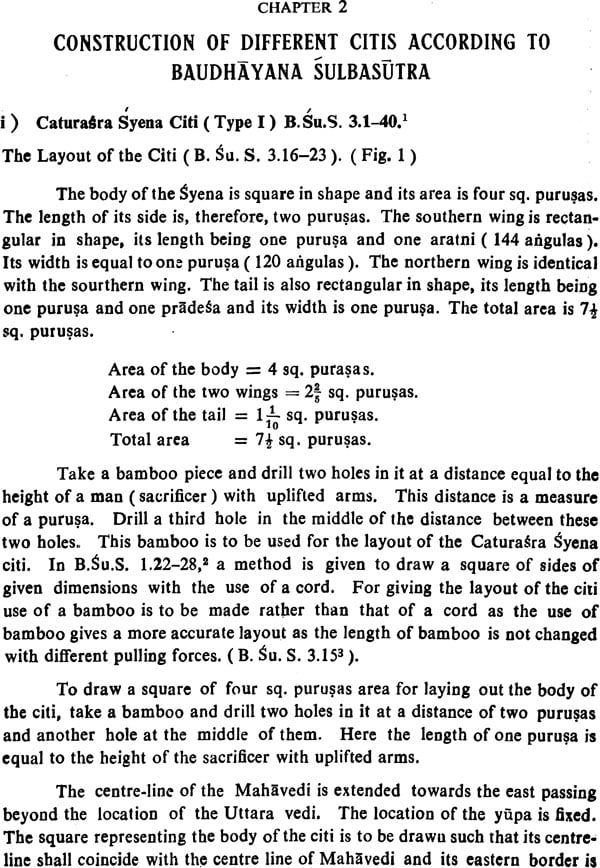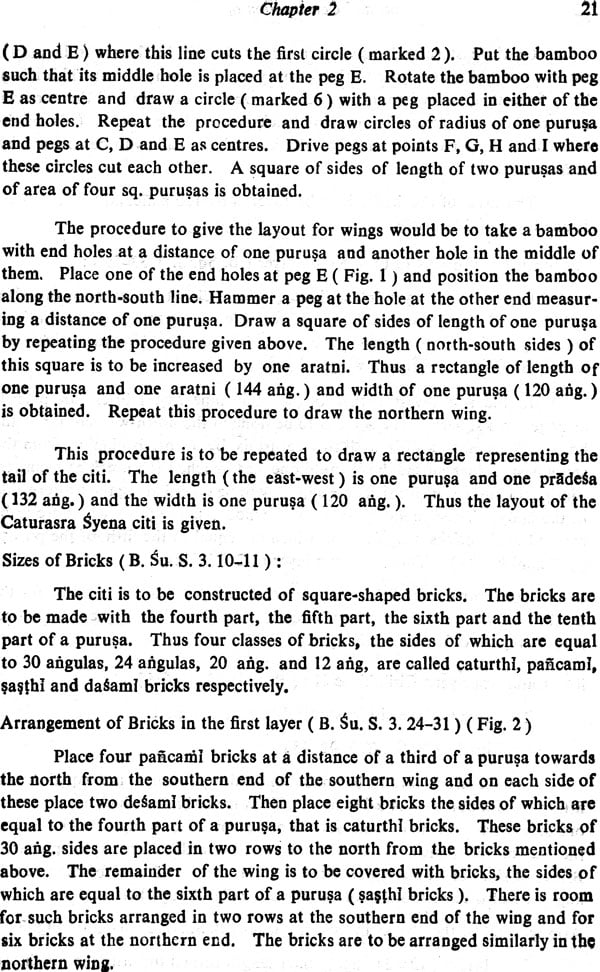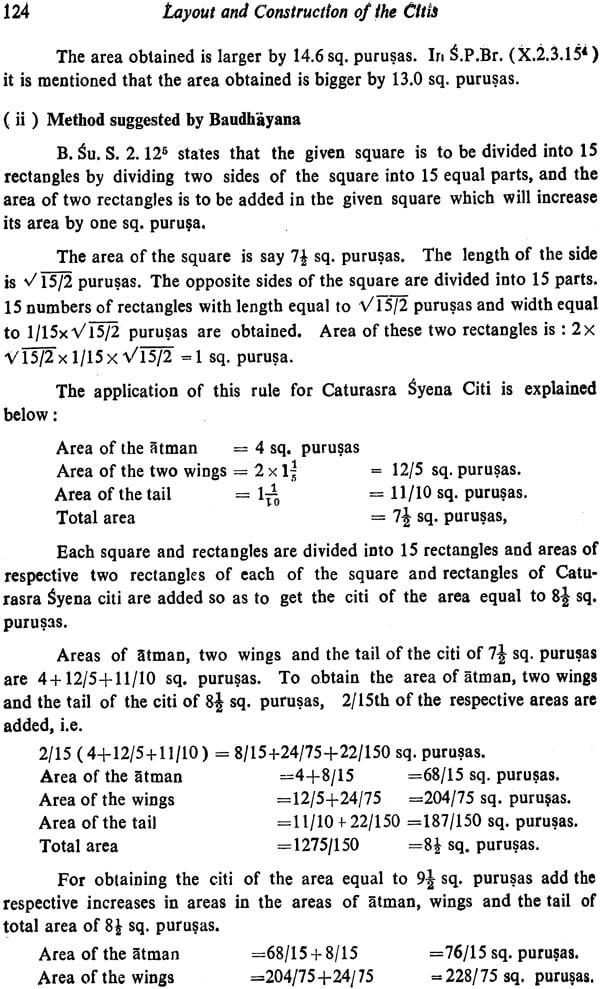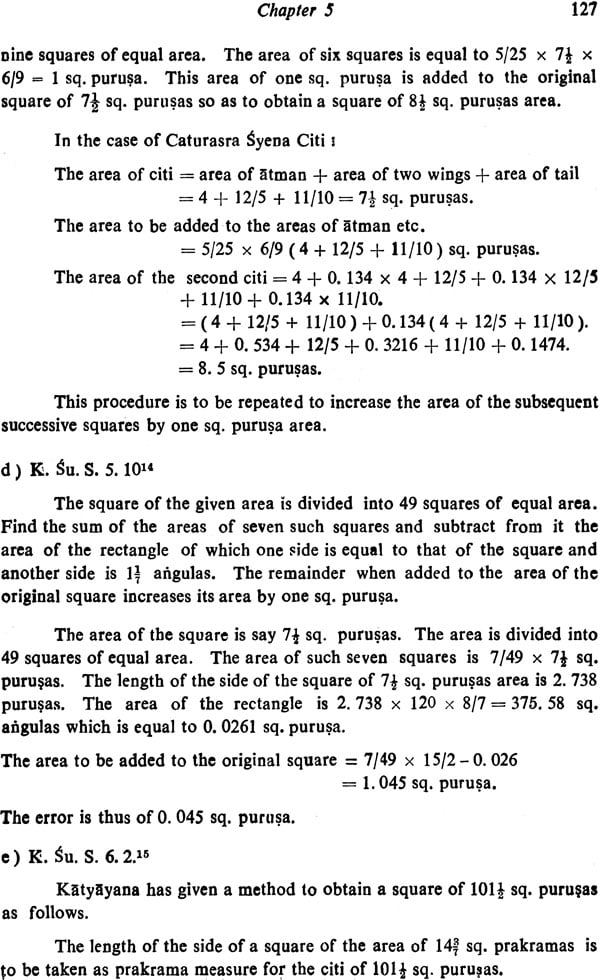
Layout and Construction of Citis According to Baudhayana, Manava and Apastamba Sulbasutras
Book Specification
| Item Code: | NAG518 |
| Author: | R.P. Kulkarni |
| Publisher: | Bhandarkar Oriental Research Institute, Pune |
| Language: | Sanskrit text with English Translation |
| Edition: | 1987 |
| ISBN: | 9788194039143 |
| Pages: | 180 |
| Cover: | Paperback |
| Other Details | 9.5 inch x 6.5 inch |
| Weight | 240 gm |
Book Description
It is stated by eminent scholars that the fire sacrifices from Darsa purnamasa to Soma used to be performed from ancient times. A reference to piling of a citi, agni-cayana, is, however, not found in Rgveda. The subject of Agni-cayana is dealt with in Taittirlya, Kathaka, Kapistbala, Maitrayanl, and Viijasaneyi Samhitas as well as in Taittirlya Brahmana, Taittiriya AraQyaka, and Satapatha Brahmana. Coomaraswami has stated that the verses X. 2.8 and X. 2. 26 of the Atharva-veda, when considered together, compare the piling of a citi with the 'Internal Agni-hotra.' The piling of a citi may be either a literal fact or it is done mentally.
Inscriptional evidences regarding performance of Vedic Sacrifices:
Sacitika Soma sacrifice is performed for the fulfilment of a particular wish of the sacrificer. They are, therefore, called kamya sacrifices. Inform- ation about the name of tbe citi and the wish of the sacrificer that can be fulfilled by performing a Soma sacrifice with that citi as Uttaravedi is given in the table below.
Name of citi The desire of the sacrificer that is satisfied. Syenaciti To reside in heaven after tbe life on this earth is ended. Praiigaciti To have large numbers of relatives. Ubhayah Praiiga To destroy troublesome relatives. Dronaciti To have abundance of food. Ra thacakraciti Same as for Praligaciti. Smasanaciti To be prosperous in Pitrloka. Kurmaciti To conquer Brahmaloka.
It can be seen that for an ambitious king who wanted to establish his dominion on as large a country as possible and to declcare it to the world by performing an Asavamedha sacrifice, the wishes mentioned in the table above were quite ordinary. Inscriptions giving information about performance of a Soma sacrifice including piling of a citi are, therefore, rather rare. On the other hand, the loftiest ambition of a king in ancient times was to perform Asvamedha sacrifice after overpowering his enemies. It is but natural that quite a good number of inscriptional evidences are available regarding perfromance of Asvamedha sacrifices by different kings. As Agnicayana was also conducted during Asvamedha sacrifices these evidences are given below. could also be surmised that the kin~s who performed important sacrifice like Asvamedha, Vajapeya, etc. might have performed Soma sacrifices with Agnicayana.
It is evident from the epigraphical records that several sacrifices such as Dvadasaratra, Triratr a, Saptasoma, Sastiratra, Pundarlka, and Vajapeya were performed in the Kusana period. The Vakataka king Pravarasena I, not content with sacrifices such as Vajapeya, Agnistoma, Aptoryama, etc., performed as many as four Asvamedha sacrifices. In the inscriptions of his successors, Pravarasena I is styled as Caturasvamedba-yajin.
The Iksvaku king Santamula I, who ruled in the second quarter of the third century A.D., performed horse sacrifices, Vajapeya, and other sacrifices. The Bhnrasivas are credited with taking not less than ten sacred baths (Avabbrtha snana ) on their completion of horse sacrifices.
Several Srauta sacrifices were performed in the post-Mauryan period. Patafijali refers to Agnistoma, Rajasuya, Asvamedha, and several domestic sacrifices performed by Pusyamitra Sunga. The inscriptions record the per- formance of Asvamedha by Pusyamitra, the Sunga king. Sarvatata, the son of king Gajayana Para sari of Satavahana period also performed Asvarnedha sacrifice.
In C. P. inscriptions of the Vakiitaka queen Prabhavatl Gupta, Samudragupta is described as the performer of many horse sacrifices ( aneka-asvamedha-yajtn s. One of Samudragupta's coins commemorates the Asvamedha sacrifice. It shows on the obverse a spiritual horse standing before a sacrificial post and ou the reverse the figure of the queen empress. The legend reads: "The king of kings, who performed Asvamedha sacrifice, baying protected tbe earth, wins heaven. (Accession of Samudragupta to the throne may be placed between A. D. 340 and 350). Kumaragupta (who reigned between A. D. 415-455), son of Candragupta Il, also performed an Asvamedha sacrifice.
Sivaskandavarman, who ruled about the beginning of the fourth century A. D. (dominions from Krsna to South Pennar and to Bellary Dt. ), performed an Asvamedha,
Salankayana king, ruling over the land between the mouths of Krsna and Godavari (during the second quarter of the fourth century), performed an Asvamedha sacrifice.
On a copper plate of Ganga king, Kongaui-Maharaja (481 A.D.?) it is mentioned that SrI Krsnavarma, Maharajadhiraja, was anointed with final ablutions of the completed horse sacrifice.
Visnukundin king named Madhavavarrnan (A. D. 535-585), ruler of Andhra country, is said to have performed eleven Asvamedbas and one thousand Agnistomas ( or other sacrifices ), as given in ChikuIJa, Ramatlrtha, Jpur and Polamaru plates.
Pulakesin I (c. A. D. 533-566) performed Asvamedba, Agnistoma, Agni-cayana, Vajapeya, Bahusuvarna, and Pundarlka sacrifices.
NarayaQavarman or his predecessor ( first half of sixth century A. D. ), a king of Kamarupa ( Assam ). Performed two Asvamedha sacrifices.
Bhutivarman, after Narayanavarman (middle of the sixth century A D.), performed an Asvamedha sacrifice. Stbitavarman, grandson of Bhiitivarman, is said to have performed two Asvamedha sacrifices.
According to Ganjam copper plate, Sainyabhita II (c. A. D. 615) of Orissa performed great sacrifices like Asvamedha.
Ayasobhita II (or III), son of Sainyabhita II, performed Vajapeya, Asvamedha, and other sacrifices.
An inscription states that Adityasena, son of Madhavagupta (third quarter of the seventh century), performed three Asvamedhas.
It is mentioned in the Masulipatam (?) plates that Vijayaditya III (A. D. 844-888) performed Asvamedha sacrifice.
In Cambay plates of Govinda IV, son of Indra III (A. D. 930 ), Darsapumamasa, Rajasuya, Vajapeya, Agnistoma, etc., are mentioned. At the time of Caulukyan Gujarat when Siddharaja (1186-1200 A. D.) built Sahasralinga tank he erected on its banks shelters (mathas and salas) for performing different kinds of sacrifices, for reciting puranas, etc.
It is seen from the above-mentioned inscriptional record that the Srauta sacrifices were being performed, almost without interruption, from Vedic period to Medieval period, throughout India, from Gujarat to Assam and from Magadha in north to Andhra country in the south. Although only one inscription, namely that of Pulakesin I, could be quoted in which performance of Agnicayana is specifically mentioned, it could be presumed that the kings who had performed important sacrifices like Asvamedha, Vajapeya, etc., might have performed Soma sacrifice with Agnicayana.
Evidences of performance of Agnicayana from Archaeological Excavations:
This information is divided into two groups. Information regarding kundas used for fire-worship as revealed in archaeological excavations at different sites is given first. This information is given in order to show that the fire-worship was in vogue in India from ancient to medieval periods. In the second group, information on citis that were found in archaeological excavations is given.
Archaeological excavations of towns beginning from Paleolithic period revealed the presence of fireplaces which were presumably meant for fire- sacrifices.
i) Fire-altars in the form of shallow oval or rectangular pits have been reported from Amri, Lothal, Kalibangan and, Atrafijikhera.
In the report on excavation at Kalibangan (Dt. Ganganagar, Rajasthan ) which is a Harappan town, it is mentioned that within one of the rooms of almost each house was found the curious fire-altar, sometimes also in successive levels, indicating their recurring function. At Kalibangan there were three horse-shoe-shaped enclosures, each with a terracotta stump in the centre and terracotta cakes. One of these cakes bears an engraving of a goat led by a man on one side with a horned headdress on the other. This might represent a goat-sacrifice. It is further stated that there were series of fire-altars on one of the platforms in the southern rhob of the citadel complex. Besides, there was another area (KLB-3) which was used exclusively for fire-altars. It lay about 80 meters to the east of the lower town. A large room with four to five altars was duly identified.
Circular pits discovered at Atranjikhera in PGW level may have sacri- ficial purposes.
At Lothal were found charred skeletal remains of a bovid, a circular gold pendent with two holes, tubular cornelian bead and sberds of painted jar, along with ash in the enclosure. It is further mentioned that at Lothal shallow enclosures with a vertical brick, terracotta cakes and a few bones of animals were excavated. Such pits are regarded as "fire-altars." These enclosures were circular as well as rectangular. As there are no stoking holes for supply of fuels they could not be ovens.
ii) At Nevasa (Dt. Ahmednagar, Maharashtra ) in the stratum of early Palaeothic age, several oblong ( 75 x 90 cms ) or oval (84 cm dia. and 79 cm dia ), kunda-like constructions, located sometimes right on the lime floor were observed. With a depth of 25 cms the kundas had clay plaster on the sides which had turned red due to long contact with fire. In the centre there was invariably a clay cylinder capped by a flat stone, which too had been exposed to fire. White ash and burnt clay clods were found in kundas which may have been used for some ritualistic purposes.
iii) Oblong or circular kundas located on the floor of the houses of cha1colithic occupation were revealed in the excavations at Chandoli (Dt. Pune, Maharashtra),Within each of these stood a clay cylinder capped with a flat anvil-like stone. White ash, charcoal, lime and burnt clods of clay were found in these kundas.
iv)Excavations at Rangpur (Gujarat State) revealed a group of four circles on a mud-brick floor. These may indicate places of fire as ash, stones etc. were noticed in these circular enclosures of clay. These indicate a ritual involving domestic fire-worship throughout the occupation (2000 to 800 B. C.).
Information of citis found in archaeological excavations at different locations in India is given below:
Excavations at Nagarjunakonda revealed an Asvamedha-site. It is mentioned that immediately after the western gateway there are several distinctive ritualistic structures. A curved brick-structure resembling that of tortoise is found. It has been built in two tyres, the top cross measured 5.48 x 3. 66m and its overall depth was 1. 37m. The head-projection is shown towards the west and in the outer finish also it was exactly modelled after a Kurma ". This could be taken as Kurma Citi or altar as its peculiar narrow dimensions and deliberate shape suggested. Many small square brick cells with ashes and burnt coal were found which were apparently Ahavaniyas' and altars for the preludial ceremonies and propitiatory rites connected with the bigger' Asvamedha ' sacrifice.
It seems that the so-called' Kurma Citi' may not be a citi. All Srau-tasutrakaras of Yajurveda agree that a citi should have five layers of bricks and a citi of only two layers is not mentioned by anybody. A citi is always oriented with its front towards the east. Here, it is mentioned that the head of the Kurma is shown towards the west. Further the size of the citi is mentioned as 5. 48 m x 3. 66. m. A citi to be constructed for Asvarnedha sacrifice is said to be of area three times (i. e. 21t sq. purusas ) the area of the first citi (i. e. 7! sq. purusas ) A square of 7! sq. purusas area has sides of 328 ang, 21 t tilas which is approximately 6. 23m. A citi of 21! sq. purusas area will be a square of 10. 79 x 10.79 m sides. It is rather difficult to believe the said construction to be a kurmaciti, and that too as a part of Asvamedha sacrifice.
Citi is a platform constructed of burnt bricks and mud mortar. These platforms are of different shapes. There are citis shaped like an isosceles triangle, an isosceles rhombus. A circular citi which is constructed like a solid wheel is a replica of a soild wheel used for a present-day cart for carrying stones by vadars. But in Vedic period such a solid wheel was used for a chariot and hence it is called as a Ratha-cakra-citi. There is another citi, circular in shape and the bricks are arranged in such a way that it is a replica of a wheel with spokes. This is another variety of a Ratha-cakra-citi. A citi shaped like a drona with a handle is also constructed with bricks. This citi may be square in shape or may be circular. Similarly. there are citis resembling a tortoise and also a flying bird. The resemblance of the citi may be like a Syena or a Kafika or an Alaja bird. Such a citi has a body, a head, two wings and a tail. The bricks are arranged in such a way that the citi formed is exactly like a bird with outspread wings and a tail. It is mentioned in Baudhayana Sulba sutra ( 3.8-9 )1 that tbis citi should look like a shade of a flying bird. The resemblance is complete with feathers at both the ends of the wings. All these citis look very artistic.
The citi replaces the Uttara Vedi in Soma-sacrifice. When a citi is constructed in such a sacrifice, it is called as' Sa- agniciti 'sacrifice. The shape of the citi depends upon the desire of the sacrificer which he wanted to get fulfilled by performing the Soma-sacrifice. One who is desirous of heavenly abode constructs the Syena citi. The sacrificer who likes to gain Brahma- loka, performs the sacrifice using a citi shaped like a tortoise and so on. These are, therefore, called' kamya citis'.
The area of the citi should be 7t sq. purusa. As the citis are of different shapes, quite a good amount of geometrical knowledge is required to give the layout of the citi of a given area and also for arranging bricks. The details of the geometrical knowledge developed for the construction of these citis are given in different Sulba sutras, which are part of the Srauta-sutras. The derivations of different formulae, etc. which are given in Sulba-sutras are dealt with in the book, 'Geometry according to Sulbasutra.
| Preface | i-viii | |
| 1 | Introduction | 1-3 |
| 2 | Length measures | 3-5 |
| 2.1 | Angula measure derived from the height of the sacrificer | 5-6 |
| 3 | Fabrication of bricks | 6-8 |
| 4 | specification for bricks | 8-9 |
| 5 | Specification for the construction of a citi | 9-11 |
| References | 15-18 | |
| Construction of diferent citis according to baudhayana sulbasutra | ||
| 1 | Caturasra syena citi (type I) | 19-22 |
| 2 | Caturasra syen citi (Type II) | 22-24 |
| 3 | syena citi with curved wings and outspread tail (type I) | 24-29 |
| 4 | syena citi (type II) | 30-34 |
| 5 | kanka citi | 34-37 |
| 6 | alaja citi | 37 |
| 7 | prauga citi | 37-40 |
| 8 | ubhayatah prauga citi | 40-43 |
| 9 | rathacakra citi (pradhiyukta) | 43-44 |
| 10 | sara rathacakra citi | 44-47 |
| 11 | drona citi (square shaped) | 47-49 |
| 12 | drona citi (circular) | 49-51 |
| 13 | smasana citi | 51-54 |
| 14 | kurma citi (vakranga | 54-57 |
| 15 | kurma citi (parimandala) | 57-59 |
| References | 59-66 | |
| construciton of citis according to manava sulbasutra | ||
| 1 | Caturasra syena citi (type I) | 67-71 |
| 2 | Caturasra syen citi (Type II) | 71-73 |
| 3 | caturasra syena citi (type III) | 73-75 |
| 4 | syena citi (shaped like a flying bird) | 75-79 |
| 5 | kanka citi | 79-80 |
| 6 | alaja citi | 81-82 |
| 7 | prauga citi | 82 |
| 8 | ubhayatah prauga citi | 82-83 |
| 9 | drona citi (square shaped) | 83-84 |
| 10 | drona citi (circular) | 85 |
| 11 | Rathacakra citi (with spokes) | 85-87 |
| References | 87-92 | |
| construciton of citis according to Apastmba sulbasutra | ||
| 1 | Caturasra syena citi (type I) | 93-97 |
| 2 | Caturasra syen citi (Type II) | 97-99 |
| 3 | prauga citi | 99 |
| 4 | ubhayatah prauga citi | 99-100 |
| 5 | rathacakra citi (pradhiyukta) | 100-101 |
| 6 | drona citi (square shaped) | 101-105 |
| 7 | drona citi (circular) | 105 |
| 8 | smasana citi | 105-106 |
| 9 | syena citi (shaped like a flying bird) | 106-111 |
| 10 | syena citi(type II) | 111-116 |
| References | 116-121 | |
| methods for increasing the area of a citi by one square purusa | ||
| 1 | methods suggested by satapatha brahmana | 123-124 |
| 2 | methods suggested by baudhayana | 124-125 |
| 3 | method suggtested by manava | 125 |
| 4 | method suggested by apastamba | 125 |
| 5 | methods suggested by katyayana | 125-128 |
| References | 128-129 | |
| layout and construcion of catursra syena citi according to katyayana srautasutra | ||
| Introduction | 131 | |
| layout of the citi | 131-133 | |
| sizes of bricks | 133 | |
| arrangement of bricks | 133-138 | |
| References | 139 | |
| arrangement of bricks in citis as given in some manuscripts | ||
| Introduction | 141 | |
| 1 | caturasra syena citi according to katyayana srautasutra | 141 |
| 2 | manuscrip drawings of citis as given by raghu vira | 141 |
| 3 | ubhayatah prauga citi | 141-142 |
| 4 | prauga citi | 143-144 |
| 5 | pradhiyukta rathacakra citi | 145 |
| 6 | parimandala drona citi | 146-147 |
| 7 | caturasra drona citi | 147-149 |
| syena citi from the manuscript drawing from prajna pathasala, wai | 149-152 | |
| References | 152 | |
| ksudra citis | ||
| citi for savitra cayana | 153-154 | |
| citi for naciketa cayan | 155 | |
| caturhotra or brahmacit cayana | 155-156 | |
| citi for vaisvasrja cayana | 156 | |
| citi for arunaketuka cayana | 156 | |
| References | 157-159 |













